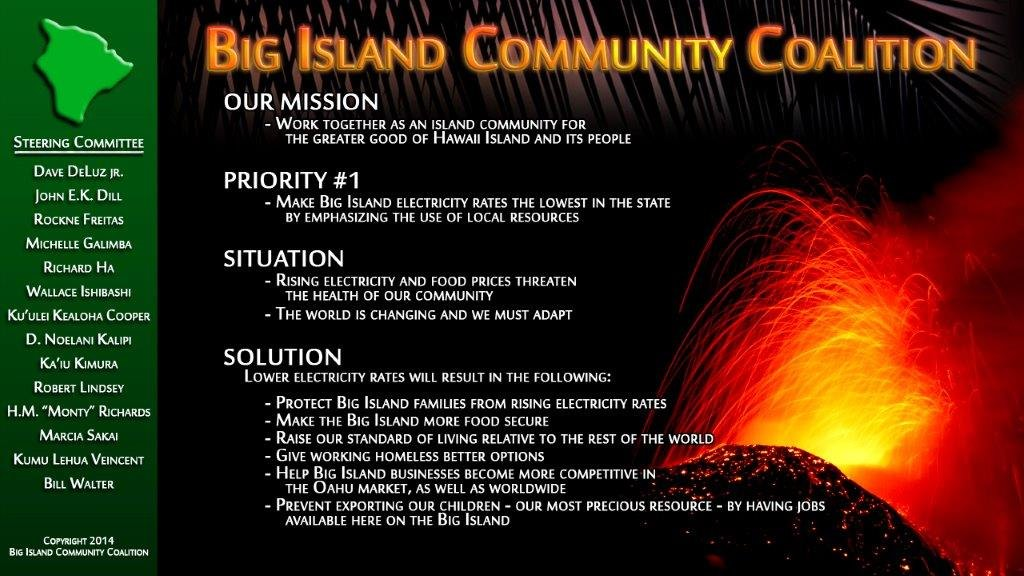Richard Ha writes:
Hawai‘i County is getting a hydrogen-powered shuttle bus. This is a significant step in the right direction for the Big Island.
Hydrogen will help with ground transportation, help other motors to do work, help with storage of energy and can even be used to make nitrogen fertilizer, leading to better food security.
As petroleum prices rise, our hydrogen costs will remain stable. Eventually we will have a competitive edge over the rest of the world. It's a step down the path to making a better future for coming generations.
From US Hybrid:
US HYBRID AWARDED CONTRACT TO DELIVER HYDROGEN-POWERED SHUTTLE BUS TO HAWAII COUNTY MASS TRANSIT AGENCY
June 17, 2014 – Honolulu, Hawaii – US Hybrid has been awarded a contract by the Hawaii Center for Advanced Transportation Technologies (HCATT) to design, integrate, and deliver its H2RideTM Fuel Cell Plug-In Shuttle Bus for operation by the County of Hawaii Mass Transit Agency’s (MTA) HELE-ON Big Island bus service. The project is funded by the State of Hawaii and Office of Naval Research via the Hawaii Natural Energy Institute (HNEI).
Integrated at US Hybrid’s Honolulu facility, the 25 passenger shuttle bus utilizes a 30 kW fuel cell fueled by a 20 kg hydrogen storage and delivery system. The fuel cell and 28 kWhr lithium ion battery power the vehicle’s 200 kW powertrain, air conditioning, and auxiliary systems. Onboard batteries are recharged by regenerative braking. The US Hybrid fuel cell, powertrain, and vehicle controller optimizes power delivered by the energy storage and fuel cell power plant.
Upon notification of the award, US Hybrid’s President and CEO, Dr. Abas Goodarzi remarked: “At this critical time in energy advancement, we are honored to have our hydrogen fuel cell vehicle technology selected by HNEI, the Hawaii County MTA and HCATT to lead the way for the adoption of zero emission mass transportation throughout the State of Hawaii.”
Hawaii Gov. Neil Abercrombie commented: “I am proud of the state’s leadership role in providing the funding to introduce the first hydrogen fuel cell electric bus in support of public transportation in Hawaii. My vision is to leverage opportunities like this to introduce clean energy transportation services that utilize our own renewable energy resources to the benefit of our local economy, while helping the people of Hawaii get where they need to go.”
Hawaii Island Mayor Billy Kenoi added: “This new fuel cell electric bus is the first tangible step in realizing our vision of transforming the County of Hawaii public bus system into one that is powered by our island’s incredible renewable energy resources. Instead of exporting our citizen’s hard-earned dollars offshore, we will be able to keep this money in our local economy creating new jobs and protecting us from the swings of the fossil fuel markets. We would also like to thank the Governor for investing in this project and allowing us to lead the way for the rest of the State of Hawaii.”
HCATT Director Stan Osserman also expressed his support for the project: “This project demonstrates that Hawaii takes its role in leading the U.S. in clean transportation technology very seriously. We’ve already established ourselves as industry leaders with Department of Defense projects related to alternative fuel vehicles, and we are moving forward to make our counties and the state leaders in hydrogen fuel cell electric vehicles.”
HNEI’s Director, Dr. Richard Rocheleau echoed these sentiments: “We look forward to evaluating the performance of this system and helping to develop ways to reduce the cost of the hydrogen infrastructure to the point where private industry can lead future hydrogen development.”
The H2RideTM Fuel Cell Plug-In Shuttle Bus is scheduled for deployment with Hawaii MTA in early 2015.
About US Hybrid
Founded in 1999, US Hybrid Corporation specializes in the design and manufacture of integrated power conversion components for fuel cell, electric, and hybrid medium- and heavy-duty vehicles, as well as for renewable energy generation and storage. US Hybrid offers comprehensive engineering expertise and experience in vehicle powertrains and components, including DC-DC converters, energy management systems, high-performance AC motors, and controllers. For more information, please visit www.ushybrid.com.
About HCATT
Managed by HTDC, HCATT has organized public/private partnerships between the federal government and private industry to develop advanced low emission and zero emission vehicles centered on electric drive technologies. Additionally, HCATT has entered into a partnership with the Hawaii Natural Energy Institute and Hawaii Volcanoes National Park to introduce zero emission, hydrogen fuel cell/battery powered hybrid electric buses into the park to support environmentally friendly tours for the millions of annual visitors to the park.
About HNEI
The Hawaii Natural Energy Institute is an organized research unit of the School of Ocean and Earth Science and Technology (SOEST) of the University of Hawai‘i at Mānoa (UHM). The Institute performs research, conducts testing and evaluation, and manages public-private partnerships across a broad range of renewable and enabling technologies to reduce the State of Hawai‘i's dependence on fossil fuel for the benefit of the citizens of Hawaii.

